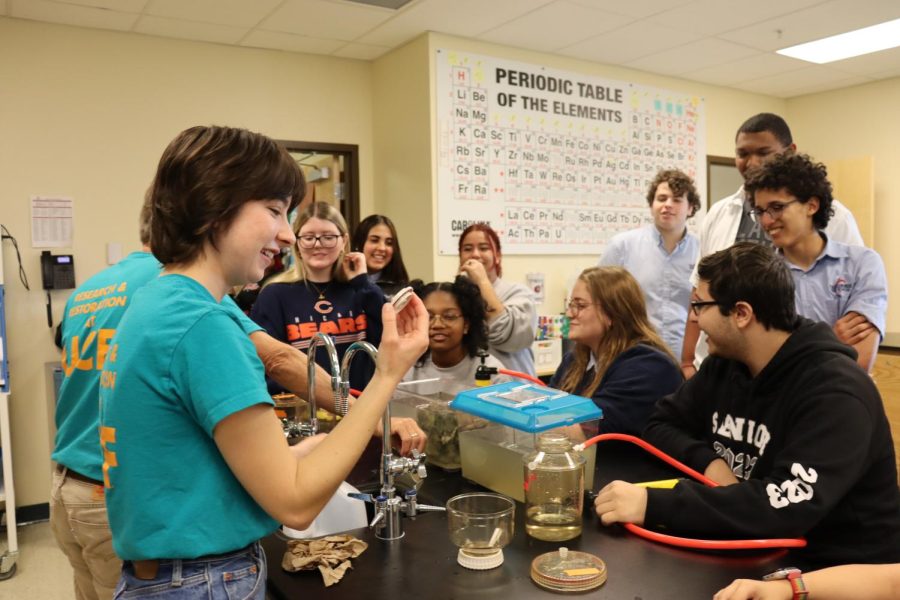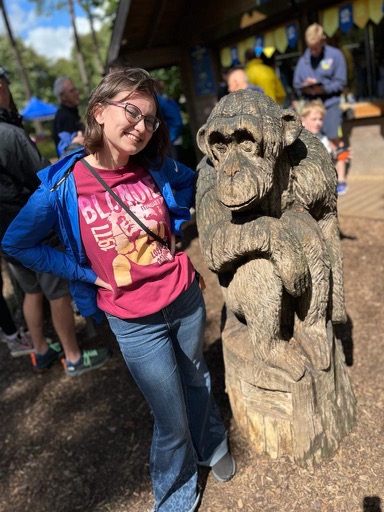Learning About Oysters
Students Learn About Oyster Conservation for UCF PhD Student’s Research
March 27, 2023
Students in the AICE Marine Science and Environmental Management classes participated in a research program meant to teach them about oyster reef conservation through different types of activities.
“We were comparing a virtual reality and real life experience of what it’s like to interact with oyster reefs, specifically, the ecosystem services and how endangered they are right now,” Junior Cynthia Valderrama explained. “Also, the impact we as humans have on oyster reefs. What we mean when we say ecosystem (services) in marine science is just how oyster reefs benefit the environment, and those organisms around them as well.”
Each class divided up into two groups, taking turns completing each activity. The program was designed by University of Central Florida PhD student Katherine Harris, along with undergraduate students from UCF’s Coastal and Estuarine Ecology Lab.
“So for the virtual reality portion, the way that has been done is I have isolated a GoPro Max camera that’s filming our oyster reefs out in the lagoon and then the videos are stitched together with Adobe Premiere, and I add narration to the videos, and then they are put into the Metaclass headsets in order to be able to view them in that immersive viewing platform,” Harris explained.
The voiceover included added information about how oysters help the environment and how oyster reefs have been degraded. As Junior Omar Grini explained, “Rather than having the habitat being brought to me, I got to technically be in the habitat. And so it was very interesting to see how, for example, boats that passed by could damage the ecosystem, as we got to literally see a boat pass by and the waves crash onto the oysters.”
During the other activity students used a touch tank to interact with organisms that live on the reefs. Before both activities and after each of them students took an assessment to gauge how much they were learning.
“I love when people get to interact with the crabs and the animals that live on oyster reefs. That’s always a really exciting thing to see, especially if people have never really interacted with these animals before,” Harris shared. “I think that’s always really exciting. You just kind of see people’s eyes light up a little more when they have their hands in the water and actually working with live animals.”
After students got a chance to identify the organisms, Harris and Field Technician Paul Sacks from CEELAB went into detail with each group to explain different conservation methods being implemented in Indian River Lagoon. Students also got a chance to try filtering water themselves, which is one ecosystem service that oysters provide people.
“One of the activities we had was basically to use a pump to try to filter water and clean it, which is something that oysters do naturally and it was quite the hand workout! So I can’t imagine how easy it must be for oysters to do that if they can filter out gallons of water, like daily,” Valderrama said.
This was the first test run of the program, which Harris titled Oyster Reef Exploration. In her research Harris is aiming to explore the difference between virtual reality and in person science communication with high school students. Overall, Harris and many students found the event a success.
“I feel like everybody had a blast, especially with the virtual reality activity. One of the things I can absolutely remember was that everybody was looking at each other through the headsets, and it was very hilarious,” Valderrama shared. “I would have expected people to be more like, you know, icky around these organisms, but there was a lot of putting on the gloves and just going right in there.”
The topic of oyster reef conservation was of special interest to the AICE Marine Science and Environmental Management classes. The marine science classes were just wrapping up discussions on ecosystems, and prepared for the activity by watching some videos on the subject. While the Environmental Management class did not discuss oysters specifically, the issue of environmental degradation was very relevant.
“The main idea behind the course is finding real life examples of these global issues in terms of the environment, one of which is habitat loss, and through the demonstration by UCF. we go to see how oysters specifically can be used as an (example) of habitat restoration,” explained Grini, who is currently taking AICE Environmental Management.
While Harris’ main goal was to conduct her PhD research on science education, she also wanted to use this program as a way to raise awareness about oysters reefs specifically. She explained that they tend to not be discussed as often as other environments, like coral reefs. Some students, including Grini, found the activities effective in fulfilling this goal.
“I feel activity like this are very useful in teaching people about why oysters matter, because it teaches them about the effects of oysters in the natural environment, which allows these people to go on and learn more about different types of habitat restoration techniques, or to to begin to partake in different forms of activism,” Grini said. “Which can help governments and societies as a whole work much harder in order to preserve and maintain these ecosystems, which are very important to life as we know it.”



